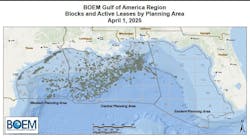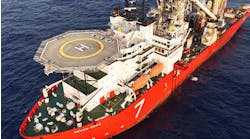New Final Well Control Rule takes effect in October
Gerard Gaudet and Matt Guy * Adams and Reese
The United States Department of the Interior published the final well control rule on Aug. 22 from the Bureau of Safety and Environmental Enforcement (BSEE). The rule clarifies blowout preventer (BOP) system regulations and modifies certain BOP equipment capability requirements, in an attempt to prevent offshore blowouts in oil and gas drilling rigs.
The final rule is effective on Oct. 23, 2023.
Here are the main takeaways from the rule and requirements you need to know:
- Requires BOPs to be able to always close and seal the wellbore to the well’s maximum anticipated surface pressure, except as otherwise specified in the BOP system requirement section of the regulations.
- Requires failure data to be reported to both a designated third party and BSEE, and failure analysis and investigations to start within 90 days of an incident.
- Requires independent third-party qualifications to be submitted to BSEE with the associated permit applications.
- Specifies that surface BOPs on existing floating facilities must follow the dual shear ram requirements when replacing an entire BOP stack.
- Requires that remotely operated vehicles be capable of opening and closing each shear ram on a BOP.
- Requires the operator to provide BOP test results to BSEE within 72 hours after completion of the tests if BSEE is unable to witness testing.
This final rule revises certain regulatory provisions that were published in the 2019 final rule entitled, “Oil and Gas and Sulfur Operations in the Outer Continental Shelf–Blowout Preventer Systems and Well Control Revisions,” 84 FR 21908 (May 15, 2019) (2019 WCR).
Arguments on both sides
In a joint DOI/BSEE press release, the regulators announced that the new measures will “enhance worker safety and ensure offshore oil and gas operations on the Outer Continental Shelf are conducted with the utmost safety and oversight standards.” The press release added that the rules will “build upon the historic regulatory reforms” implemented by the department in the aftermath of the 2010 Deepwater Horizon explosion and resulting oil spill.
BSEE Director Kevin Sligh said that: “this rule strengthens testing and performance requirements for blowout preventers and other well control equipment, provides for timely and robust analyses and investigations into failures, and clarifies reporting requirements to ensure we have appropriate visibility over information and data critical to maintaining well integrity.”
An official with the American Petroleum Institute disagreed with that assessment. In an AP story, Holly Hopkins, API vice president, said that: “Regulatory clarity is critical for ensuring compliance and establishing safe operations, but this rule continues the rampant politicization of the rulemaking process and represents another policy swing from administration to administration, resulting in a policy that fails to meaningfully improve the safety of workers or protect the environment.”
Brief history of the rule
Failure of a BOP was said to be a major cause of the Deepwater Horizon incident. BSEE adopted several recommendations from multiple investigation teams leading to the publication of the 2016 Well Control Rule. In May 2019, under President Trump, BSEE published a well control rule that the oil industry welcomed, but environmental organizations filed lawsuits towards, claiming that the rule weakened certain safety provisions.
In January 2021, President Biden issued Executive Order (EO) 13990 (“Protecting Public Health and the Environment and Restoring Science to Tackle the Climate Crisis”). Within that EO, agency actions included reviewing the 2019 well control rule to determine “that federally regulated Outer Continental Shelf oil and gas operations are conducted safely and in an environmentally responsible manner.”
According to the DOI/BSEE press release, the 2023 final well control rule incorporates lessons learned from operator experience, incident data regarding blowout preventers, and well integrity since the publication of the 2016 rule and revises or rescinds certain modifications that were made in the 2019 rule.
For now, operators, contractors, and rig managers need to be aware of the requirements of the 2023 well control rule. There is less than one month before the final rule takes effect. It is always healthy and recommended to review your internal policies and procedures and check and test your equipment. And, in performing internal maintenance checks, it is important to ensure you are compliant with the new federal regulations.
The authors
Gerard Gaudet is a partner in the Adams and Reese New Orleans office, where he practices commercial/corporate litigation and catastrophic injury litigation, advising clients in the maritime, energy, oil and gas, and construction industries. He also serves as outside general counsel to businesses, advising them on business growth, including lease agreements, construction contracts, employment issues, and vendor disputes.
Matt Guy is the leader of the Adams and Reese Maritime, Insurance, and Business Immigration practice. Matt litigates matters stemming from marine construction, maritime, marine, construction and energy insurance and all aspects of worldwide oil and gas operations. He handles brown water and blue water maritime disputes. He is a partner in both the New Orleans and Houston offices.



